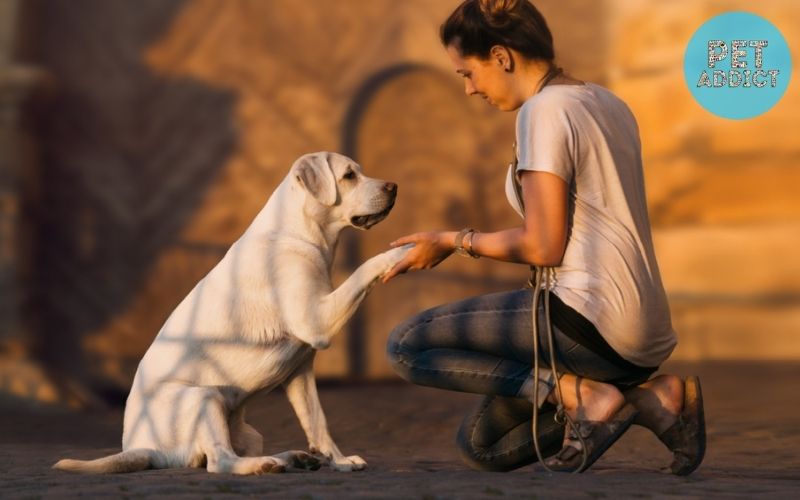The Labrador dog, also known as the Lab, is the most popular breed of retriever in America. If you want to buy Lab as a pet, let’s learn about Labrador dogs’ characteristics, care, and training with Pet Addict
PetAddict.net – The best place where you can find everything about your pet!
Where Are Labrador Dogs From

The name Labrador would make many think that they are of Labrador origin, but it is not. They originated in Newfoundland (Canada) due to a cross between a Newfoundland dog and an underwater hunting dog.
Labradors were first brought to England in 1800, to become waterfowl hounds and rapidly developed in England.
However, after coming to the United States, Labrador dogs from working dogs became the most popular family pet.
Appearance Characteristics & Personality of Labrador dogs

Appearance Characteristics
The Labrador dog has 2 breeds, the American Lab and the British Lab, in which the American Lab is popular and has a larger number. Although the purebred standards in the two countries are different, basically, the American Lab and the British Lab have the same things in common such as:
– Body Shape: long body, strong muscles. Labrador dog has an extremely strong skeleton, 4 big, strong, well-balanced legs. Male Lab dog has a height of about 55-60cm, weight 28-33kg; while the female Lab dog has a height and weight of 51-55cm and 26-30kg.
– Head and nose: The head of the Labrador is wide, the snout is long and square, the jaw is strong with many sharp teeth that can handle large prey. The large Labrador nose, usually chocolate or black, is extremely sensitive to odors, so it is able to detect prey hundreds of meters away.
– Ears, eyes, and neck: Labrador’s ears are quite long and always hang on both sides of the head. Their eyes are chestnut or black. Particularly the neck has many sinewy veins.
– Coat: thick, short hair, close to the skin and hard, waterproof. There are 3 popular coat colors: black, chocolate and yellow, in which yellow is the most. The gray and silver Labrador is rare but not recognized as purebred. Labrador’s coat divides into 2 layers. The outer layer is dry, and the inner layer is thick, soft, and waterproof. This coat will help Labrador retain body heat well and swim comfortably in cold environments.
Personality Traits
- Labrador dogs know for being affectionate, sweet dogs, always trying to please their owners
- Friendly, close, and harmonious with people.
- Smart agility
- Reliable, absolutely owner loyal to the
Experience of raising Labrador dogs
Regime Nutrition
Labrador dogs are easy to raise and are not picky eaters, so as long as they have a reasonable diet and ensure enough nutrition, they will develop comprehensively in both health and physique. Labrador’s food needs to have enough protein, fat, protein, calcium, vitamins, and minerals. Especially, when Labrador is 6 months old or older, the diet needs to increase and add a variety of nutritious foods such as meat, eggs, vegetables, bones, animal organs… to provide enough nutrients needed. essential for the body. Labrador dogs in the adult stage can gnaw on tubular bones and eat whole meat to help strengthen their teeth.

Note when feeding Labrador:
– Sanitize eating utensils clean, feed at the prescribed time
– Drinking water should available 24/24 and should be changed 3 times a day.
– Do not feed the Labrador dog a lot of rice, fatty meat, starch, fat, fish, and absolutely do not let them eat spoiled food.
– Feed Labrador a sufficient amount, if they eat too full or too hungry, they will have digestive disorders.
How to care for a Labrador Dogs?

– Labrador retrievers are easy to adapt to living conditions, just need to have a cool, clean, and not wet place.
– Regularly let Labrador exercise, for example: walking in the park, searching for games, swimming, catching balls, throwing flying saucers, etc. to exercise both physically and mentally.
– Brush once a week to remove loose hair.
– Shower once a week, when bathing in combination with checking feet, eyes, ears, should not bathe regularly.
– Brush your Lab dog’s teeth at least 2-3 times a week to remove tartar buildup and avoid bad breath. Cut nails 1-2 times/month so that the nails do not get too long, scratch the floor or cause pain for Lab dogs.
How to train a Labrador Dogs?
Labrador is quite intelligent, sociable, and friendly, so it considers an easy dog to train. Puppies can begin to meet and get to know strangers and go to different places and expose to different situations between 7 weeks and 4 months. During training you should pay attention to the following:
– Do not force Labrador or engage in violent behavior such as whipping, chain control
– Let Labrador be free to exercise to help prevent them from being stress.
– Just use the fun and comfortable training method to be able to obey and follow the owner’s control commands
– A few easy actions that most Labrador dogs can do are shaking hands, picking up balls, twirling, etc.

After being trained, Labrador dogs will be involved in many rescue activities, search and detect bombs and drugs and support other things.
What is the price of Labrador dog?
The price of a Labrador puppy will vary from breeder to breeder, and from place to place. In the USA as a rough guide, you are looking at $800 to $1200.
The cost of a Labrador puppy in India can range from 4000-5000 Rs up to as high as 1 lac.
How long to Labrador Dogs live?
The average Labrador dog lifespan is 12 to 12.5 years.
Read more: Dog
Conclusion
Above is some information about the Labrador Retriever breed. Hopefully through the above article can help you have an overview of Labrador dogs. Do not forget to visit the petaddict.net website to find more useful information about other pets.




